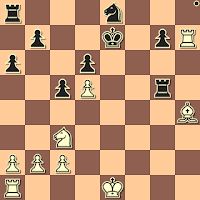My first game to finish in the Chess.com tournament "Piano Piano"(time control: 1 move / 3 days) went something like this:
1.e4 e5 2.Nf3 Nc6 3.Bc4 Bc5 4.Bxf7+ Kxf7 5.Nxe5+ White won on time
In fact, it went exactly like that.
I would love to say that the Jerome Gambit simply scared the daylights out of my opponent, but a glance at the tournament standings - which show other timeout losses - suggests that the demands of the real world may have intruded upon his playing at this time. I wish him well.
By the way, the Chess.com computer analyzed my game and was a bit skeptical, rating my moves with 53.7 accuracy (not sure what that means) against my opponent's 99.7 accuracy, while noting You outlasted your opponent even after making a mistake.You outlasted your opponent even after making a mistake.
























